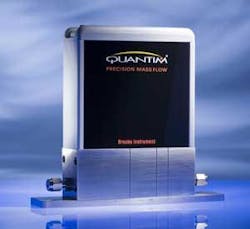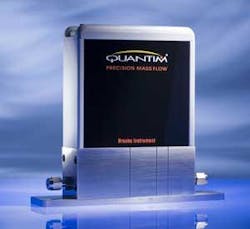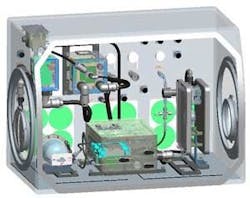Flow Controller Makes Quantum Leap
By Jim Hollis
Brooks Instrument sends its Quantim flow controller into space via NASA project to handle purified water for the International Space Station.
Delivering saline solution to a clinic for medical needs... sounds simple enough, right? Not when the clinic is on the International Space Station, the moon or even Mars. Transporting medical fluids manufactured on Earth into space is expensive and logistically challenging. Officials at NASA Johnson Space Center knew there had to be a way to manufacture medical fluids in space to alleviate the transportation problems and make spacecraft more self sufficient, so they called on the microgravity science expertise and spaceflight hardware development know-how of NASA Glenn Research Center and ZIN Technologies Inc., both in Cleveland, OH.
ZIN Technologies engaged Brooks Instrument to help. V-F Controls, Brooks Instrument’s sales representative in Mentor, OH, recommended the Quantim Coriolis mass flow controller as ideal to measure the water flow through a purification system to a standard IV bag that was prefilled with salt crystals and a magnetic lab stirrer.
“The Coriolis mass flow technology was previously tested by NASA and had already been shown to work in reduced gravity,” said ZIN Technologies’ Dan Brown. “We chose the Brooks Quantim because of its accuracy at the low flow range the application requires.”
Still, this isn’t the first time Brooks products have contributed to the space program. In the 1960s, Brooks Sho-Rate variable area meters (rotameters) were used to leak test space suites. And in the 1990s, after the Challenger disaster in 1986, Brooks thermal mass flowmeters were used to leak test the space shuttle o-rings. Now, Brooks Quantim Coriolis mass flow controllers are making their way into space to ensure that astronauts have medical fluids on demand for emergency needs. Construction features of this device are critical in this application because it doesn’t only need to work in zero gravity, but spaceflight electronics also typically must pass a rigorous 6.8G RMS workmanship vibration test. The standard series unit proved to be rugged enough for vibration levels and the long trip to the space station.
An initial prototype of the medical fluid generation system called IVGEN (IntraVenous Fluid Generation) is currently being installed into a laboratory glove box on the station. The prototype consists of an accumulator for pumping potable water, a filter unit with the Quantim installed, a data collection and control unit, a mixing module, and an IV bag with salt crystals. In operation, potable water is transferred into a bladder inside the accumulator. Nitrogen is pumped into the accumulator forcing the water through the device, then through a series of filters, and into the IV bag. The flow rates range from 15-25 ml/min and accuracy is very important in the application. The results from the first test conducted on the station will be returned to Earth and tested for proper filtering and mixing with the salt crystals. Once IVGEN is proven to be successful, the system will be scaled accordingly to meet the requirements of manned missions to the moon and Mars.
About the Author: Jim Hollis is marketing communications manager at Hatfield, PA-based Brooks Instrument LLC, a leading flow measurement and control instrument provider since 1946 with manufacturing sites, regional sales and service offices in the Americas, Europe and Asia. Contact: 888-554-3569 or www.brooksinstrument.com


